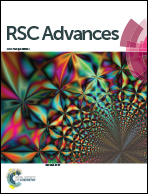Well-defined gold nanoparticle@N-doped porous carbon prepared from metal nanoparticle@metal–organic frameworks for electrochemical sensing of hydrazine†
Abstract
In this work, a composite material of Au nanoparticles (Au NPs) encapsulated in N-doped porous carbon (Au@NPC) was prepared through a one-pot thermolysis of Au NPs@zeolitic imidazolate framework (Au@ZIF-8) precursor. The obtained Au@NPC possessed a high specific surface area as well as superior thermal and chemical stability. The NPC shell functioned as a barrier to effectively prevent Au NPs from dissolution, migration and aggregation during the carbonization process and electrochemical testing, while it allowed the transit of electrolyte to the Au NPs surface. The core–shell structure and Au content were related to the preparation conditions. When the concentration of Au NPs was 0.5 mg mL−1, the resulting Au@ZIF-8 could be carbonized to form a core–shell structure. The size of the encapsulated multi-core Au NPs slightly increased with enhancing carbonizing temperature (e.g. from 600 to 800 °C), while the Au content and surface area of the obtained composite material also increased. On this basis, a sensitive and stable electrochemical sensor was constructed for the detection of hydrazine. Under the optimized conditions, a linear dynamic range of 80 nM to 466.28 μM, with a satisfactory sensitivity of 2035.4 μA mM−1 cm−2 and a comparable detection limit of 8 nM (S/N = 3), was obtained. Moreover, it only lost 4.7% activity after one-month storage. This strategy could also be used to prepare other metal–carbon composite materials for constructing sensors.


 Please wait while we load your content...
Please wait while we load your content...